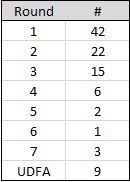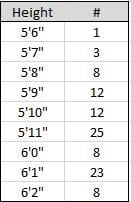Rookie Rebuilding – Part 2: Running Backs
In Part 1 of this series, we examined the last decade of fantasy performance for the quarterback position. We now turn our attention to the running backs over that same period.
I’ll be covering a fair amount of information from multiple angles in an attempt to glean useful information from player traits, characteristics, drafted situation and fantasy selection toward determining if we can improve our draft success by using history as a guide. Over the past decade at DLF, if you’ve followed me that long, you may recall a recurring annual piece named “By the Numbers” where I broke down fantasy performance over a period of time based on where rookies were drafted both in the NFL and in fantasy. It was a popular piece for obvious reasons. This series is the 2017 version and a bit expanded at that.
I wanted to zoom out a bit with respect to the information I have been looking at when it comes to evaluating rookie selections to their ultimate fantasy performance. At the root level, I’m most interested, as always, in seeing the trends that form from highly selected NFL players to see if it translates to fantasy. In some cases, it has been very clear while, in others, not so much. Obviously, clear trends can be acted upon, such as the very high likelihood that an NFL drafted receiver taken within the first six selections has a very high likelihood of being a fantasy stud, or at least highly productive. Same goes for the historical trend of NFL first round tight ends performing well in fantasy. Interestingly enough, both trends have been impacted over the past five years. We’ll get to that later in the series.
For running backs, it’s been a decade of change. Once the go-to position in drafts, we’ve seen the rise of the Running Back By Committee (RBBC) take the wind from the sails of the position to the zero running back strategy in fantasy drafts to, now, arguably a bit of a resurgence at the position. But that doesn’t necessarily aid you come your rookie draft day. If you’ve read any of my previous works on the topic, you know that there’s no greater minefield early in your draft than that of the highly-drafted running back. Plagued by greater injury occurrence, reduced career length, committee approach, bad systems, poor team performance and a host of other variables, forecasting running back production from college to the NFL is a difficult proposition at best. In most cases, you are selecting with a great deal of excitement and even more hope. Neither of which translate to the gridiron.
But what if we knew more about the mold of successful running backs, those physical characteristics that make the player. These are traits that are difficult to train and provide the foundation for success at the next level. If we wish to go even deeper, what about these same traits when folded into the situation of the teams drafting them? Between these items and a decade of history, perhaps we can steer clear of those backs that exist on the line and, instead, overweight those that better fit the mold. Of course, no amount of research guarantees success of failure of this work for, if it did, we would not have such mold-breakers as Russell Wilson, Drew Brees, Darren Sproles or even a LeGarrette Blount. Those players exist well outside the ‘norm’ of physical traits to those that have found success before them.
Based on previous statistical work many years ago, I had ascertained that the perfect running back size, for myself at least, was 5’11” and 218 lbs. This was determined by performing a similar study to that below. Not a perfect science as size and weight certainly don’t dictate performance alone, but over time, a trend may show itself.
I’ve always been a fantasy coach that would much rather execute a blend of aggressiveness within a trend that increases my chances of success. Not to say that I don’t make the occasional reach of an undersized player, but I always know when I’m reaching. And you should too.
Let’s dive in first by looking at the past decade of top ten fantasy performers at running back, their NFL drafted situation and their height/weight measurements.
*Apologies for the misspelling of DeAngelo Williams’ name in my matrix below.




Draft Position
Unlike the previous quarterback data which shows a VERY clear trend of top fantasy quarterbacks being selected in the first round of the NFL draft, we have a very interesting distribution for running backs.
Take a look at the distribution from rounds one through six specifically:

We have a very even decline through the first six rounds of the NFL draft. Now take a look at those that went undrafted (UDFA) altogether, a number greater than those selected from rounds five through seven.
- 42% of the running backs holding a top ten position in fantasy performance over the past decade were selected in the first round of the NFL Draft
- 64% were selected in the first two rounds
- 9% were undrafted BUT no UDFA player other than Arian Foster (4) repeated his top-ten performance
- Of the 36 players NOT selected in the first two rounds, 13 of them (13%) only appeared on the list once
At running back, we know that a top-ten ranking does leave a big gap in performance from those ranked near the top to those near the bottom. I looked at the top five for each year and found:
- 18 of top-five performers came from round one
- 16 came from round two
- 7 came from round three
- 3 came from round four
- 1 from round seven
- 5 were UDFAs (Arian Foster (4) and Danny Woodhead)
Again, a relatively even distribution.
Looking at this, it certainly appears that you can rank running back value based on the round that the back was selected in the NFL Draft, over-weighting backs taken in higher rounds and devaluing them as they fall.
Height
Before going much further, let me warn us not to get overly carried away by what this data shows. Those truly of the statistical discipline could well shoot holes in this type of study. So while I am somewhat of a statistical mind, I’m far more interested in doing the quicker work toward spotting trends rather than a any sort true statistical thesis. I’ll leave that to the true statisticians out there, of which we have a couple at DLF.
Here is the break down of the the top-ten fantasy performers over the past decade related to his height:

The nice part about using a decade of top ten performance is the fact that we get an even 100 ranking slots. This was not by accident, I assure you.
Recall that earlier I had mentioned that my own preference was for running backs at the 5’11” height measurement and a weight of 218 pounds. This preference was formed about eight years ago and still seems to hold water today. So let’s review some specifics:
- 25% of the running backs holding a top ten position in fantasy performance over the past decade were 5’11”. Only slightly less (23%), were 6’1″ for a total of 48% of the total spots
- By concentrating on running backs ranging from 5’9″ to 6’1″, 80% are represented
- Backs 5’8″ or shorter or taller than 6’1″ represent 20%
Looking at the spread across the heights, it’s easy enough for me to key on the second bullet point above. Size does seem to matter, but will this change when we merge in the weight characteristic?
Weight
We’ve seen some relatively even distribution up until this point so what will individual weights of the top performers tell us?

Weight distribution between the datasets of 200 and 229 pounds is surprisingly even. I decided to break the weights down for those backs selected in the first round of the NFL Draft:
- Of the 42 first-round-selected running backs, 64.3% were between 210-229 pounds
- 21.4% were in the 200-209 pound range
- 14.3% were above 230 pounds
Looking at second round running backs, since 64% of top-ten backs were selected in the first two rounds:
- Of the 22 second-round-selected running backs, 77.3% were between 200-219 pounds
- 9.1% were 220-229 pounds
- 13.6% were over 230 pounds
Summary
What does all of this mean. Unfortunately, it’s not as clear as was the quarterback position, but there is still enough data here to use in my opinion.
With a clear distribution of top running backs coming from the first round, declining relatively evenly as we descend rounds, the data does suggest weighting running backs by the round selected, which should be no surprise. 64% of top-ten performers in fantasy over the past decade came from the first and second rounds of the NFL draft. When considering those 13 (13%) backs that only graced the list a single time, this clearly suggests strongly over-weighting first and second round selected players, at least if you want a top-ten performer.
Height consideration is not as clear as I had hoped it would be, though a full 25% of performers were 5’11”. But with a full 55% of performers at 2″ to either side (5’9″ – 6’1″), while we can favor 5’11” as the preferred size, we cannot rule out others close to it. 5’9″ – 6’1″ is the preferred height.
Now adding in weight, we can see a relatively even distribution from 200 – 230 pounds. Not ideal for gaining greater clarity other than to under-weight (no pun intended) backs below 200 pounds or above 230 pounds. But, when considering the weights of first and second-round-selected backs, the rounds where most performers are produced, the 210 – 219 pound range is favored as the class that factors prominently in both rounds. But it’s clear that with running backs, variability does occur enough to allow for reaches away from the averages if done so wisely.
It’s not overwhelmingly clear, but my original research finding an ideal size of 5’11″/218 lbs. does seem to be in the sweet spot.
As we get into the fantasy draft analysis later in this series, reviewing fantasy performance related to fantasy draft position, much of this will start to take better shape. Ultimately, the goal will be to use all parts of this series to make better draft-day decisions toward determining if that coveted draft selection would turn into a fantasy standout or if it makes more sense to trade picks for known commodities. Perhaps then, at least when looking at a decade of history, we can determine whether building through the draft is a solid strategy or a fool’s errand.
Follow me on Twitter: @DLF_Jeff
- Lineup Advice: Wrap-up, Thank You and Goodbye (TTFN) - January 1, 2024
- Lineup Advice: Week 17 – Championship Edition - December 26, 2023
- Lineup Advice: Week 16 – The “What is” Edition - December 19, 2023


































































